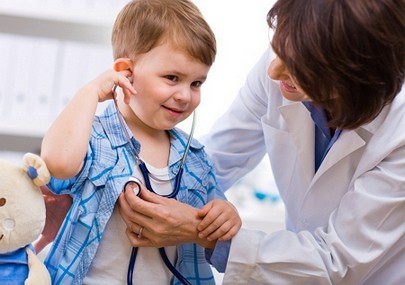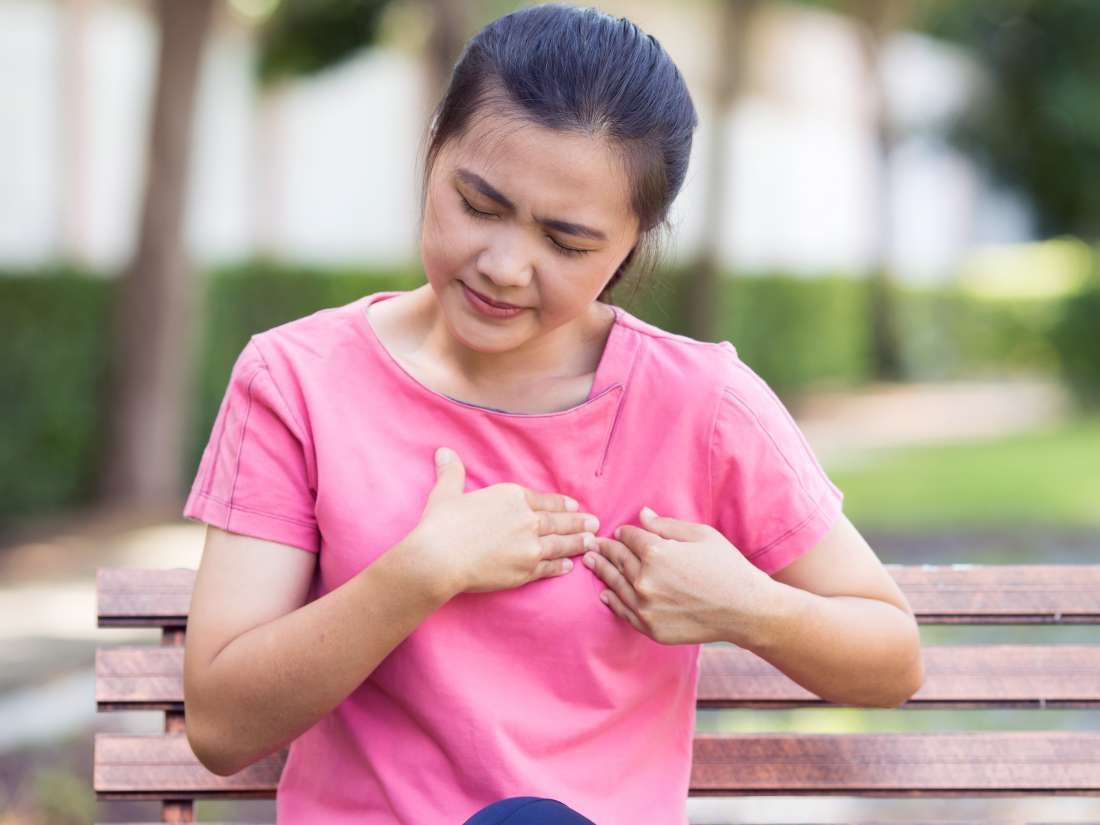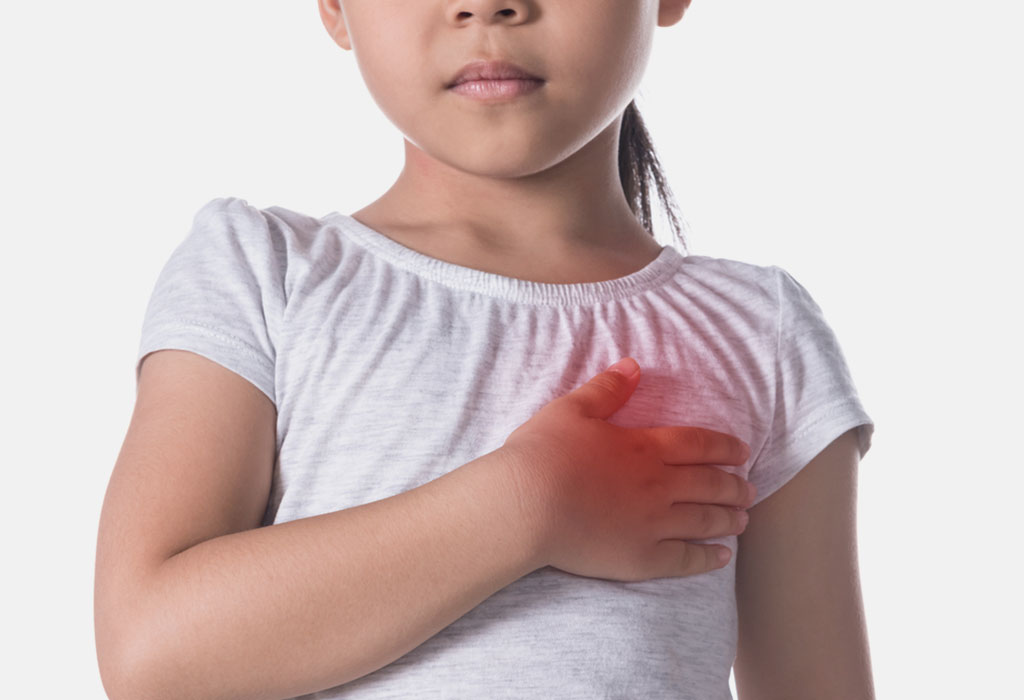Chest Pains in Children

Contents:
- Child has Pain in Chest
- Causes of Chest Pain in Children
- The Pain of Diseases or Injuries of the Skin
- Chest Pain in the Child Due to Diseases of the Locomotor System
- Chest Pain in a Child With the Diseases of the Respiratory System
- Chest Pain in a Child With Cardiovascular Diseases
- Chest Pain in the Child With Diseases of the Digestive System
- Psychogenic Chest Pain
- Sudden Severe Stabbing Pain of Unclear Etiology
- Chest Pain in a Child Due to a Muscle Strain or Muscle Injury
- How to Determine the Disease by the Nature of Chest Pain in a Child?
Child has Pain in Chest
Adults often associate chest pain in a child with heart ailments. But in fact it isn't so. Studies conducted in the United States showed that chest pain at adolescents and young children is not associated with heart disease in 99 % of cases. This study involved no less than 3575 children from Boston with pain in heart, patients of Boston hospital, and only in 1 % of them doctors found cardiovascular disease. What are the causes of chest pain in children and what to do about it?
Causes of Chest Pain in Children
Children with average age barely reaching 14 years participated in the study of which we wrote above. In 99 % of them diseases of the bones, locomotor system, digestive system, the central nervous system have been revealed. Some children had chest pains occurred due to uncontrolled intake of drugs, which caused the allergy. And only 1 % of children experienced chest pain due to cardiovascular problems. Therefore, doctors strongly advise parents who found chest pain in their children to do first of all an ECG.
This will immediately remove the risk of cardiovascular disease or heart problems. Further you need to navigate on the picture of the disease. This will make it possible to avoid wasting time on use of drugs against cardiovascular diseases, if there are none at all. This time will be needed to identify the real causes of chest pain in children.
So the causes of chest pain in children can be:
- Psychogenic pain;
- Pain due to injuries or diseases of the skin;
- Pain in muscle work disorders;
- Pain due to diseases of the respiratory system;
- Pain because of cardiovascular diseases;
- Pain due to lesions of the gastrointestinal tract.
First you need to ask the child in detail where exactly he has pain because small children very often indicate different places that cause pain. Therefore, a stitch in child's side, pointing to diseases of the digestive system, can easily be confused with chest pains-both parts of the body a child may call chest. Ask the child about the nature of the pain. Are they acute, piercing or blunt, pulling? When does the pain occur in child's chest? After the meal, while making movements, after active sports? Let's look at each of the causes of chest pain in a child in more detail.
The Pain of Diseases or Injuries of the Skin

The pain of diseases or injuries of the skin can be causing discomfort for the child, if he has herpes, or zoster. This disease can cause rash, slight wounds or bubbles at the skin. And then the child complains of burning pain in the chest. They may be accompanied by fever or lymph nodes, which are significantly increased.
How to Help?
Zoster, or herpes is a viral disease that is also infectious, that is passed from child to child. To cure it, you should call the district doctor and follow the treatment regimen that he would prescribe.
Chest Pain in the Child Due to Diseases of the Locomotor System
Chest pain in the child because of disease of the locomotor system may be quite strong and acute. Sources of pain can be modified vertebrate ganglions after the injury, pain due to cartilage lesions in the spine, rheumatoid arthritis, tuberculosis. All these diseases lead to incarceration of the nerve roots, and it is very painful.
How to Help?
You need to take the child to the rheumatologist to diagnose and prescribe the treatment.
Chest Pain in a Child With the Diseases of the Respiratory System
Chest pain in a child often can be caused by injury or pneumonia. This respiratory organ is surrounded by pleura-a membrane that covers the chest cavity. When the pleura is inflamed, it leaves (it consists of very thin leaves ) rub against each other, and it causes extreme pain in the chest of the child. They are very hard to tolerate, the pain amplifies even more during deep breathing and may radiate in the shoulder joint.
How to Help?
Such pain a child may experience when pneumonia is aggravated, the lungs are in grave condition, they are inflamed and stricken with virus. In such a state, the self-medication is inadmissible. You should immediately call a doctor and treat the child in a hospital, usually with antibiotics.
Chest Pain in a Child With Cardiovascular Diseases
Cardiovascular chest pain in a child is one of the most dangerous types of pain. They can occur at different diseases of the heart and blood vessels, in particular rheumatism, ARI (acute respiratory infections), which trigger inflammation of the lining of the heart – pericardiumis or inflamed heart muscles (a disease is called myocarditis). Cardiovascular diseases not associated with myocardial infarction or stenocardia can be recognized by a blunt and dragging pain, such pain can irradiate (spread) in the neck or shoulder.
If you are not sure what disease causes pain, you should definitely listen to the child with a stethoscope. And then the doctor can hear noises in the area of the heart that "keep up" with each heart beat, that is, synchronously. Chest pain in a child with cardiovascular diseases may also become stronger during swallowing or deep breathing.
How to Help?
If the heart and blood vessels are not in normal condition – it is a big danger for the child. You need to immediately consult your doctor. He will prescribe the treatment depending on the nature of the disease.
Chest Pain in the Child With Diseases of the Digestive System

Chest pain in the child with diseases of the gastrointestinal tract can be very strong and indicate serious problems with health. It can be congestion in the digestive tract, heartburn, inflammation of the esophagus, which doctors called esophagitis as well as poisoning by substances that can irritate the delicate mucous membrane of esophagus or stomach.
Diseases of the digestive system that cause pain in the chest of the child could be gastric or duodenal ulcers, hernia holes of the esophagus, foreign body, which the child swallowed (e.g., a stone). Such pain can be recognized by nature: they become stronger when swallowing, lying or when the child leans forward. Accompanying symptoms are difficulty in swallowing, vomiting with blood, stool with black secretions, as well as increased salivation.
How to Help?
You need to immediately call an ambulance and take the child to a hospital. Above all, he needs to do endoscopy of the esophagus (esophageal inspection using computer diagnostics and the device called endoscope). Then a doctor will prescribe a treatment depending on the disease the child suffers.
Psychogenic Chest Pain
Psychogenic chest pain may begin when the child is not sick, but is going through a state of acute stress. Then in the chest arise muscle disease and the child complains of chest pain. The child may also worry about the state of a person close to him, for example, mom, and mimic the chest pains that plague her. Psychogenic pain can be defined by the time when it occurs. Typically, these pains are bothering the child only in the waking state, and during the sleep or when the child is playing or reading an interesting book the pains disappear.
How to Help?
You need to give a child more time to rest, to play, be outdoors. If the chest pain does not disappear, you need to show the child to a neurologist and a psychologist.
Sudden Severe Stabbing Pain of Unclear Etiology
Sudden severe stabbing pain of unclear etiology may occur in a child often after meals or with strong physical tension. This pain can be accompanied by contractions in the chest area (bouts of pain), and is located at the top of the abdomen or at the bottom of the chest. As a rule, such pain is more frequently localized on the right side. Causes of such pain can be strained ligament between the ventral sheath (peritoneum) and diaphragm.
How to Help?
The pain of this nature in a child should disappear after he rests and calms down. The child should lie, peritoneal ligaments will relax and then all pain will be gone. Even without medication.
Chest Pain in a Child Due to a Muscle Strain or Muscle Injury

Chest pain because of problems with muscles may occur after injury, muscle sprains, bruises, and also due to the viral infection in the muscles. The last disease leads to inflammation of the muscles, which is called a viral myalgia. It is characterized by the fact that the child's chest muscles become very painful, and the pain comes suddenly, it is strong, and is felt even with light pressure with the fingers. The locus of pain, as a rule, is only this and other deviations in the status of the child are not present.
How to Help?
For bruises and sprains you need to alternate heat and ice (by 15 minutes). Warm compresses can be salt heated on a griddle or a warm hot-water bottle. You can also heat the woolen shawl on a warm radiator and attach to a child's sick chest.
If the chest strongly hurts, you can give something of the anti-inflammatory drugs and a pain reliever, such as ibuprofen. You can also give the child a Panadol – it finely relieves pain and inflammation.
How to Determine the Disease by the Nature of Chest Pain in a Child?
If the pain gets worse with movement, is likely to be caused by an injury or muscular tension. It could also be sprains of muscles or their inflammation. Parents should pay attention to these symptoms even if there are no bruises or other signs of injury on the child's chest An additional symptom is pain with a light touch, breath, coughing.
If chest pain of the child focuses only in one place, which hurts constantly, this may be the result of a fracture of the rib. Additional symptoms are acute pain when moving, touching, and this pain is on a locus of a rib. This pain does not radiate anywhere.
Strong and sudden chest pain of the child as if for the sternum – it is a symptom of tonsillitis or colds. This pain can be caused by disease of the trachea, in particular, its inflammation. Microorganisms that cause angina and tracheitis are the same. An additional symptom of this disease is a dry cough, pain, increasing with deep breathing.
Pain in the chest of the child in the form of stinging that occurs after eating is a sign of diseases of the digestive system, in particular the stomach. This pain is caused by acid, which rises from the stomach back up into the esophagus. There are children who most often suffer heartburn and hyperacidity. To avoid this condition, do not overeat and bend over after eating, but sit up straight. If these simple remedies don't work, you need to take a child to the doctor.
Pain in the chest of the child while coughing is a symptom of diseases of the respiratory system, particularly pneumonia. If the child coughs often and long, therefore his intercostal muscles can stretch, they become inflamed and cause pain. Pain is accentuated by palpation of the chest. These pains will subside quickly, as soon as the coughing is gone.
Whatever the child's chest pain, you should not lose sight of this symptom, because it can be a sign of a serious illness. In order not to make sure that these diseases are present in practice, it is necessary to pay attention to them in an initial stage, to be able to diagnose and to treat.